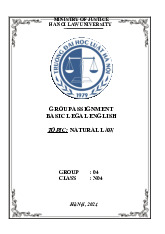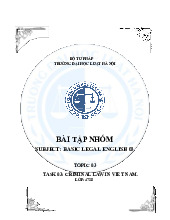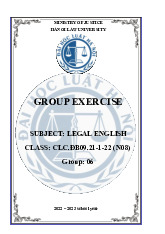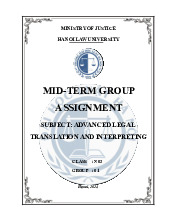

















Preview text:
lOMoAR cPSD| 58412604 MINISTRY OF JUSTICE
HAN OI LAW UNIVERS ITY GROUP WORK MID-TERM ASSIGNMENT COURSE: Basic Legal English 1 TOPIC: What is civil law? Major: Legal English Class: 4826 - N04 Group: 04 Hanoi, 2023 lOMoAR cPSD| 58412604
MINUTE DETERMINING THE INVOLVING LEVEL AND
PARTICIPATION RESULTS IN GROUP WORK ACTIVITIES
Date: December 7th, 2023 Venue: A1101 Group: 04 Class: 4826 – N04
Total number of students in the group: + Attended: 3 + Absented: 0
Course: Basic Legal English 1
Topic: What is civil law?
Determining the level of participation and results of each student's participation in the
involvement of group work activities, the outcomes are as follows: Students’ self- Teachers’ assessment Students’ assessment Students’ No. ID FULL NAME signature number
Grade Teachers’ A B C Grade signature ( in numbe )
r ( in word) 1. 482642 PHUNG NGOC MINH 2. 482646 TRINH HANG NGA 3. 482647 NGUYEN BAO NGOC
The outcome of the group work assignment
Hanoi, September 25 th , 2023 - The overall grade :…………………
+ The first teacher’s assessment :………………… GROUP LEADER
+ The second teacher’s assessment :…………………
- The result of the presentation :…………………
- Teacher grading the presentation :………………… Trinh Hang Nga lOMoAR cPSD| 58412604
- The final assessment of the teacher :…………………
A. INTRODUCTION .............................................................................................. ii
B. CONTENT .......................................................................................................... 1
I. DEFINITION ................................................................................................... 1
1. Legal system ................................................................................................. 1
2. Civil law ....................................................................................................... 2
II. SOURCE OF CIVIL LAW ............................................................................ 2
III. CHARACTERISTICS OF CIVIL LAW .................................................... 4
IV. COUNTRY WITH CIVIL LAW SYSTEM ................................................ 5
1. Introduction ................................................................................................. 5
2. Component ................................................................................................... 6
3. Influence ....................................................................................................... 6
V. COMPARE CIVIL LAW WITH COMMON LAW .................................... 6
C. CONCLUSION ................................................................................................. 11
D. REFERENCES ................................................................................................. 13 A. INTRODUCTION
Civil law systems, also called continental or Romano-Germanic legal lOMoAR cPSD| 58412604
systems, are found on all continents and cover about 60% of the world. They are
based on concepts, categories, and rules derived from Roman law, with some
influence of canon law, sometimes largely supplemented or modified by local
custom or culture. The civil law tradition, though secularized over the centuries
and placing more focus on individual freedom, promotes cooperation between human beings.
In their technical, narrow sense, the words civil law describe the law that
pertains to persons, things, and relationships that develop among them, excluding
not only criminal law but also commercial law, labor law, etc. Codification took
place in most civil law countries, with the French Code civil and the German BGB
being the most influential civil codes. lOMoAR cPSD| 58412604 lOMoAR cPSD| 58412604 B. CONTENT I. DEFINITION 1. Legal system
A legal system is the framework of rules, procedures, and institutions that a
community uses to interpret and enforce their laws. A legal system is binding on all
legal disputes within its jurisdiction.
There are generally considered to be five legal systems in the world today:
civil law, common law, customary law, religious law, and mixed legal systems:
Civil law systems have their origin in the Roman legal tradition. Civil
systems vary widely, both in procedural and substantive law. Nations with civil law
systems have comprehensive, frequently updated legal codes. Most importantly,
case law is a secondary source in these jurisdictions. France and Germany are two
examples of countries with a civil law system.
Common law systems, while they often have statutes, rely more on
precedent, judicial decisions that have already been made. The legal system in the
United States is a common law system (with the exception of Louisiana, which has
a mix of civil and common law).
Customary law systems are based on customs that have come to be
accepted as legal requirements or rules of conduct within a particular country. The
laws of customary legal systems are usually unwritten and are often dispensed by
elders, passed down through generations.
Religious legal systems are systems where the law emanates from texts
or traditions within a given religious tradition. Many Islamic nations have legal
systems based in whole or in part on the Quran.
Mixed legal systems refer to legal systems where two or more of the
above legal systems work together. lOMoAR cPSD| 58412604 2. Civil law
Civil law defines the rights and responsibilities of individuals, government
entities and private or non-government organisations in their interactions with each
other. A breach of a civil law right or obligation does not usually lead to criminal processes and sanctions. What the civil law is (1):
A comprehensive system of rules and principles usually arranged in
codes and easily accessible to citizens and jurists.
A well organized system that favors cooperation, order, and
predictability, based on a logical and dynamic taxonomy developed from Roman
law and reflected in the structure of the codes.
An adaptable system, with civil codes avoiding excessive detail and
containing general clauses that permit adaptation to change.
A primarily legislative system, yet leaving room for the judiciary to
adjust rules to social change and new needs, by way of interpretation and creative jurisprudence. II. SOURCE OF CIVIL LAW
The written law and legal institutions of Rome serve as the foundation of
civil law in all of its forms. Its name is derived from “jus civile”, the civil law of
the Roman Republic and Empire.
Jurists-those persons "learned in the law", or who could be described as
legal experts—made fundamental contributions to the development of the Roman legal system.
What is the Civil law?, https://law.lsu.edu/clo/civil-law-online/what-is-the-civil-law/, truy cập 02/12/2023
In the Roman Republic, before the beginning of the Empire, in the second
century B.C. A group of jurists, had emerged by the end of the Republic, in 27 B.C. lOMoAR cPSD| 58412604
had gained prominence within the legal system, independent of the courts of law.
They came from upper class, interested in law and in providing law as public
service without pay, such as giving advices to parties to litigation, the lay judiciary
who presided at trials and judged the facts of a case, and to legal magistrates who
instructed the lay judges on issues, procedures, and remedies available in particular cases.
The Roman Empire's expansion resulted in increasing trade with conquered
areas as well as distant places with which Rome came into contact, bringing
Strangers who did not come under customary Roman law to Roman cities, towns.
As a result of these changes, a private law regime was required to determine and
guide relationships between citizens and noncitizens.
In addition, The short-term, nonprofessional character “the Roman judicial system
and its method of disposition of cases was reason for the jurists’development.
There were two types of judges:
The magistrate (praetor): elected for a one-year term. The praetor's judicial
competence was restricted because his duties consisted of conducting what a
modern lawyer would call pretrial hearing between potential litigants to clarify the
issues of the conflict. The control over the remedies available to the litigants was
the praetor's source of power. The praetors' edicts, which were legal
pronouncements, became the principal source of private law, with legislation
serving as a secondary source.
The judge for the trial (judex): During the trial, the judex, on the other
hand, played the usual role of judge. His appointment was considerably more
limited than that of the praetor. The judex was chosen on an ad hoc basis by the
litigants to preside over their trial, and then given authority by the praetor to resolve only that case.
Both praetors and judges required good legal advice from jurists because lOMoAR cPSD| 58412604
of their lack of legal training. Futhurmore, jurists gave written technical advice to
judges and other relevant parties of the law, assited assisted the chief praetor draft
the Edict, an annual public proclamation issued by the Chief Praetor outlining the
principles by which he intended to manage his office, which played an important
role in the development of Rome's equity law that could apply to those who were
not considered native Romans and prepared interpretation of textual material in
document called responsa for praetor and judex.
As a result, the Roman legal system never gave judicial decisions any
weight. In the preface of his Institutes, published in the second century A.D., the
prominent Roman jurist Gaius rejected the idea that judicial rulings could serve as
the foundation for Roman law. Furthermore, in the sixth century, the Emperor
Justinian hammered the last nail in the coffin of Roman judicial precedent (and
judicial precedent in other systems as well) by dictating in the Corpus Juris Civilis,
an encyclopedia, that "decisions should be rendered in accordance, not with
examples, but with the law" ("non exemplis sed legibus judicandum est"). III.
CHARACTERISTICS OF CIVIL LAW .
There is generally a written constitution based on specific codes (e.g.,
civil code, codes covering corporate law, administrative law, tax law and
constitutional law) enshrining basic rights and duties; administrative law is
however usually less codified and administrative court judges tend to behave more like common law judges;
Only legislative enactments are considered binding for all. There is little
scope for judge-made law in civil, criminal and commercial courts, although in
practice judges tend to follow previous judicial decisions; constitutional and
administrative courts can nullify laws and regulations and their decisions in such cases are binding for all.
In some civil law systems, e.g., Germany, writings of legal scholars have lOMoAR cPSD| 58412604
significant influence on the courts;
Courts specific to the underlying codes – there are therefore usually
separate constitutional court, administrative court and civil court systems that
opine on consistency of legislation and administrative acts with and interpret that specific code;
Less freedom of contract - many provisions are implied into a contract
by law and parties cannot contract out of certain provision IV.
COUNTRY WITH CIVIL LAW SYSTEM 1. Introduction
The Napoleonic Code (French: Code Napoléon), officially the Civil Code
of the French (French: Code civil des Français; simply referred to as Code civil), is
the French civil code established during the French Consulate period in 1804 and
still in force, although frequently amended since.
The code, with its stress on clearly written and accessible law, was a
major milestone in the abolition of the previous patchwork of feudal laws.
Historian Robert Holtman regards it as one of the few documents that have influenced the whole world.
The Napoleonic Code is the most widespread system of law in the world,
in force in various forms in about 120 countries.
The Napoleonic Code was not the first legal code to be established in a
European country with a civil-law legal system; it was preceded by the Codex
Maximilianeus bavaricus civilis (Bavaria, 1756), the Allgemeines Landrecht
(Prussia, 1794), and the West Galician Code (Galicia, then part of Austria, 1797). It
was, however, the first modern legal code to be adopted with a pan-European lOMoAR cPSD| 58412604
scope, and it strongly influenced the law of many of the countries formed during
and after the Napoleonic Wars. 2. Component
A prominent example of a Civil Code is the Napoleonic Code (1804),
named after the French emperor Napoleon. The Napoleonic Code consists of three components: • Human law • Property law • Commercial law 3. Influence
The Napoleonic Code influenced developing countries outside Europe
attempting to modernize and defeudalize their countries through legal reforms,
especially in Latin America and the Middle East V.
COMPARE CIVIL LAW WITH COMMON LAW
Similar: Both legal systems share similar sources of law, they have
statutes and case law, and they take distinct approaches to regulation and issue resolution. Difference: Civil Law Common Law
Sources of law The main sources of law are The main sources of law are statutes, case law or
codes and statutes created by the precedent.
legislature, and legal scholars' writings. lOMoAR cPSD| 58412604 Origin
Civil law has its origin in Roman law, as codified in the The original
Corpus Iuris Civilis of Justinian. Under this influence, in source of the
the ensuing period the civil law has been developed in common law
Continental Europe and in many other parts of the world. system can be traced back to the English monarchy.
Legal System Legal system originating in Europe whose most Legal system
prevalent feature is that its core principles are codified characterized
into a referable system which serves as the primary source by case law, of law. which is law developed by judges through decisions of courts and similar tribunals. lOMoAR cPSD| 58412604 Role of Makes rulings; judges sets precedent; referee between lawyers.Judges decide matters of law and, where a jury is absent, they also find facts. Most judges Chief investigator; makes rarely inquire rulings, usually non-binding extensively
to 3rd parties. In a civil law into matters
system, the judge’s role is to before them,
establish the facts of the case instead relying on arguments and to apply the provisions presented by of the applicable code. the part Though the judge often brings the formal charge. Countries
Spain, China, Japan, Germany, most African nations, all United States,
South American nations (except Guyana), England, most of Europe Australia, Canada, India
Constitutions he constitution is generally based on a code of laws, or Though not a
codes applying to specific areas, like tax law, corporate rule, common law, or administrative law. law countries may not always follow a constitution or a code of laws. lOMoAR cPSD| 58412604
Precedent Only used to determine administrative of constitutional Used to rule court matters on future or present cases Role of
In cases of civil law, the opinion of the jury may not have Juries are jury
to be unanimous. Laws vary by state and country. Juries comprised
are present almost exclusively in criminal cases; virtually only of
never involved in civil actions. Judges ensure law prevails laypersons over passion. — never judges. In the U.S., juries are employed in both civil and criminal cases. Their function is to weigh evidence presented to them, and to find the facts and apply the law. lOMoAR cPSD| 58412604 Type of Adversarial. argument Lawyers ask and role questions of of witnesses, lawyers demand production of evidence, and present Inquisitorial. Judges, not cases based lawyers, ask questions and on the demand evidence. Lawyers evidence present arguments based on they have the evidence the court finds. gathered.
Evidence Evidence demands are within the sovereign inquisitorial Widely Taking
function of the court — not within the lawyers’ role. As understood
such, “discovery” by foreign attorneys is dimly viewed, to be a
and can even lead to criminal sanctions where the court’s necessary role is usurp part of the litigants’ effective pursuit or defense of a claim. Litigants are given wide latitude in US jurisdictions, but more lOMoAR cPSD| 58412604 limited outside the US. C. CONCLUSION
The emergence of a plurality of legal systems has rendered a reform of
the Civil Code necessary. The unity of the Civil Code has been affected by the
coexistence of two regimes: the first regime being a legal framework common to lOMoAR cPSD| 58412604
several areas, the second regime being made up of specific rules.
It is the form as well as the text itself which need to be reformed. France
has been looking for answers, which can be found in the supremacy of the
legislative process and the European legal system. lOMoAR cPSD| 58412604 D. REFERENCES * Textbook
Basic legal English (Using language in legal contexts) * Website
1. Legal system: https://www.law.cornell.edu/wex/legal_systems#:~:text=A
%20legal%20system%20is%20the,legal%20system%20across%20the %20globe.
2. Civil lawhttps://law.lsu.edu/clo/civil-law-online/what-is-the-civil-law/
https://www.justice.vic.gov.au/justice-system/laws-and-regulation/civil-law 3. Country with civil
lawhttp://lapphap.vn/Pages/tintuc/tinchitiet.aspx?tintucid=207525 French:
https://libguides.law.villanova.edu/FrenchLegalResources
Napoléon code: https://learn.saylor.org/mod/book/view.php?id=54759 4. Compare
https://thads.moj.gov.vn/noidung/tintuc/lists/nghiencuutraodoi/ view_detail.aspx?itemid=1072




